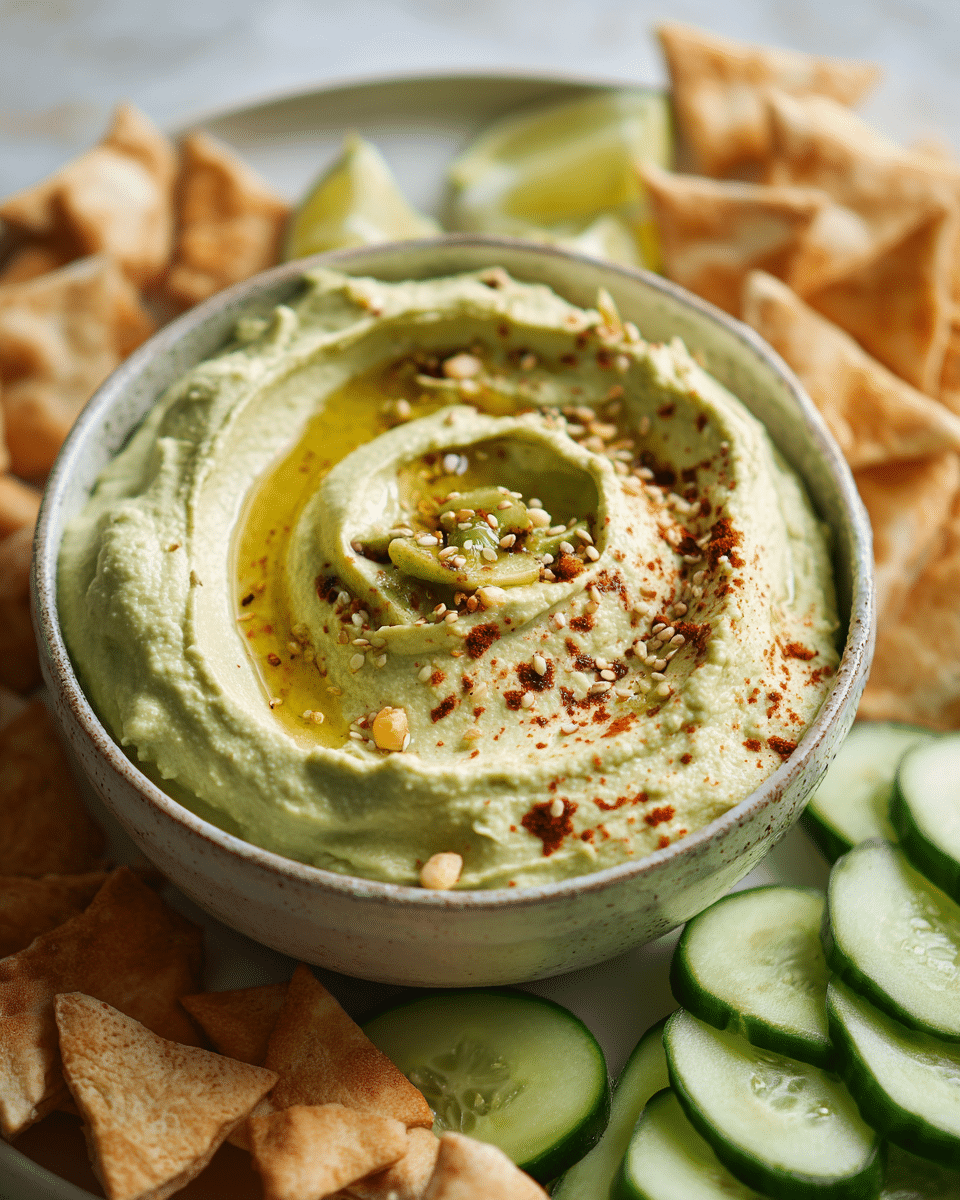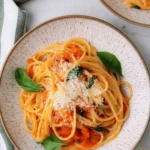Garlic Scape Hummus puts a unique spin on the classic Middle Eastern dip by replacing traditional garlic cloves with fresh garlic scapes — the curly, green stalks that grow from garlic bulbs. This seasonal ingredient adds a milder, slightly sweet garlic flavor that blends beautifully with the creamy texture of chickpeas and tahini.
FULL RECIPE
Ingredients
- 1 can (15 oz) chickpeas, drained and rinsed
- 1/3 cup chopped garlic scapes (about 3–4 scapes)
- 1/4 cup tahini
- 3 tablespoons lemon juice (freshly squeezed)
- 2 tablespoons olive oil (plus extra for drizzling)
- 2–3 tablespoons cold water (as needed for consistency)
- 1/2 teaspoon salt
- 1/4 teaspoon ground cumin (optional)
- Paprika or sesame seeds for garnish (optional)
Directions
- In a food processor, combine the chickpeas, chopped garlic scapes, tahini, lemon juice, and salt. Blend until the mixture starts to come together.
- With the processor running, slowly drizzle in the olive oil and continue blending until smooth.
- If the hummus is too thick, add cold water 1 tablespoon at a time until you reach your desired consistency.
- Taste and adjust seasoning, adding more lemon juice or salt if needed.
- Scoop the hummus into a serving bowl. Use the back of a spoon to create a swirl on top, then drizzle with a little olive oil.
- Garnish with paprika, sesame seeds, or additional chopped garlic scapes, if desired.
- Serve with pita bread, crackers, or fresh vegetables.
Nutrition Facts
- Calories: 90
- Total Fat: 6g
- Saturated Fat: 1g
- Trans Fat: 0g
- Cholesterol: 0mg
- Sodium: 120mg
- Total Carbohydrates: 7g
- Dietary Fiber: 2g
- Sugars: 0g
- Protein: 3g
- Vitamin A: 0% DV
- Vitamin C: 2% DV
- Calcium: 2% DV
- Iron: 4% DV
What Are Garlic Scapes and Why Use Them in Hummus
Garlic scapes are the curly, green flower stalks that grow from the bulbs of hardneck garlic plants. Often overlooked or discarded, they offer a milder, greener, and slightly sweeter garlic flavor than traditional cloves. Their texture is tender yet crisp, making them perfect for blending into dips like hummus. When used in place of raw garlic, garlic scapes provide a more subtle garlic undertone without the harsh bite, allowing other ingredients like chickpeas, tahini, and lemon to shine more clearly. They also add a beautiful green tint and a fresh seasonal element to the classic spread.
Flavor Profile and Texture of Garlic Scape Hummus
Garlic Scape Hummus boasts a harmonious blend of creamy, tangy, and garlicky flavors with an herbaceous twist. The scapes introduce a vegetal brightness that elevates the traditional richness of hummus without overpowering it. Their green flavor adds depth while keeping the dip light and refreshing. The texture is silky and smooth when blended properly, especially when balanced with olive oil and tahini. The scapes also contribute a faint crunch if not fully pureed, which can add a textural contrast depending on preference.
Nutritional Benefits
This version of hummus is not only flavorful but also highly nutritious. Chickpeas are a rich source of plant-based protein and dietary fiber, which help with satiety and digestion. Tahini provides healthy fats, calcium, and magnesium, while olive oil contributes heart-healthy monounsaturated fats. Garlic scapes themselves contain antioxidants, including allicin, known for supporting heart and immune health. Lemon juice adds a dose of vitamin C. Overall, this dip is low in saturated fat and cholesterol-free, making it a heart-smart snack or appetizer when eaten in moderation.
Dietary Suitability and Modifications
Garlic Scape Hummus is naturally vegan and gluten-free, making it suitable for a wide range of dietary preferences and restrictions. It can easily be adapted for low-sodium diets by reducing the added salt and using no-salt-added chickpeas. For oil-free diets, the olive oil can be replaced with additional tahini or a small amount of aquafaba (the liquid from canned chickpeas) to retain creaminess. Those watching fat intake can reduce the tahini slightly and substitute part of it with plain, unsweetened yogurt or avocado for a lighter but still creamy version.
Serving Suggestions and Presentation Ideas
This vibrant green hummus makes an eye-catching addition to any appetizer table or mezze platter. It can be served as a dip with pita chips, raw vegetables like carrots, cucumbers, and bell peppers, or even as a spread in wraps and sandwiches. For a rustic look, swirl the hummus into a bowl and drizzle with olive oil, then top with chopped herbs, sesame seeds, or a dash of smoked paprika. Its color and creamy texture also make it ideal for pairing with colorful crudités in picnic baskets or lunchboxes.
Flavor Pairings and Ingredient Complements
Garlic Scape Hummus pairs beautifully with ingredients that enhance or contrast its earthy garlicky flavor. Bright, acidic vegetables like cherry tomatoes, pickled onions, or roasted red peppers balance the richness, while herbs like parsley, dill, or mint add extra freshness. Whole grains like farro, quinoa, or couscous also pair well when hummus is used as a sauce or side. For a Mediterranean twist, serve it with kalamata olives, grilled halloumi, or falafel. Its creamy texture and complex taste allow it to shine as both a condiment and a component of larger meals.
Seasonal Appeal and Ingredient Availability
Garlic scapes are a highly seasonal ingredient, typically harvested in late spring to early summer, making this hummus a seasonal specialty. Farmers’ markets and organic groceries are the best sources for fresh scapes, which may not be available year-round. Because of this, the recipe often becomes a fleeting summer favorite that showcases fresh, local produce. For year-round versions, chopped chives, green garlic, or a smaller quantity of traditional garlic may be used as substitutes, although they’ll slightly alter the flavor.
Storage Tips and Shelf Life
Like traditional hummus, Garlic Scape Hummus should be stored in an airtight container in the refrigerator. It stays fresh for 4 to 5 days, although the flavor may intensify slightly as it sits. To maintain peak freshness, drizzle a thin layer of olive oil on the surface before sealing the container, which helps preserve moisture and prevents oxidation. For longer storage, hummus can be frozen in small portions and thawed in the refrigerator when needed. However, note that the texture may become slightly grainy after freezing, so a quick blend or stir can help restore its smoothness.
Creative Culinary Uses Beyond Dipping
Garlic Scape Hummus isn’t just for snacking—it can be a versatile addition to everyday meals. Use it as a base for grain bowls, a protein-rich topping for roasted vegetables, or a sandwich spread in place of mayo. Stir a spoonful into soups or stews for extra creaminess and flavor depth. It can also be thinned out with lemon juice and water to become a tangy dressing for salads. Thanks to its bold yet balanced flavor, it integrates seamlessly into both light and hearty meals, helping you make the most of your batch.
Advertisement
Sustainability and Reducing Kitchen Waste
One of the great appeals of this hummus is its use of garlic scapes, which are often trimmed and discarded in commercial garlic farming. By using this flavorful part of the plant, home cooks can reduce food waste while discovering a unique ingredient. Incorporating scapes into your cooking not only minimizes discarded produce but also supports sustainable food systems by making full use of local, seasonal harvests. This hummus is a perfect example of how creative recipes can transform overlooked ingredients into delicious, waste-reducing dishes.
Conclusion
Garlic Scape Hummus is more than just a seasonal twist on a beloved classic—it’s a celebration of flavor, nutrition, and sustainability. With its creamy texture, fresh green color, and delicate garlicky taste, it offers a refreshing alternative to traditional hummus. Whether served as a dip, spread, or dressing, it adapts easily to various diets and culinary styles. By embracing lesser-used ingredients like garlic scapes, this recipe also supports a more thoughtful approach to cooking. It’s a simple yet impactful way to bring freshness and creativity to your table while honoring the full potential of every ingredient.






